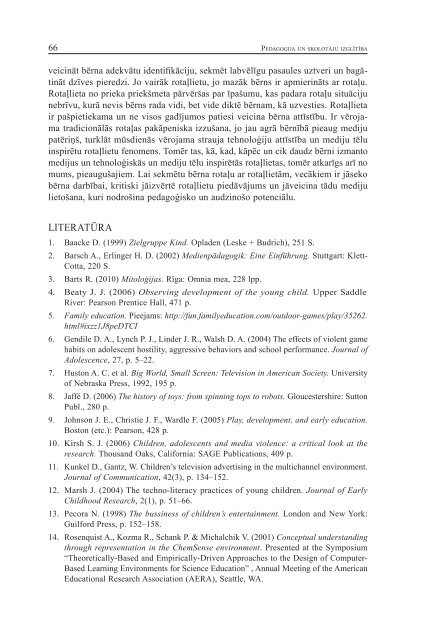Create successful ePaper yourself
Turn your PDF publications into a flip-book with our unique Google optimized e-Paper software.
66 Pe d a g o ģ i j a un s k o l o t ā j u i z g l ī t ī b a<br />
veicināt bērna adekvātu identifikāciju, sekmēt labvēlīgu pasaules uztveri un bagātināt<br />
dzīves pieredzi. Jo vairāk rotaļlietu, jo mazāk bērns ir apmierināts ar rotaļu.<br />
Rotaļlieta no prieka priekšmeta pārvēršas par īpašumu, kas padara rotaļu situāciju<br />
nebrīvu, kurā nevis bērns rada vidi, bet vide diktē bērnam, kā uzvesties. Rotaļlieta<br />
ir pašpietiekama un ne visos gadījumos patiesi veicina bērna attīstību. Ir vērojama<br />
tradicionālās rotaļas pakāpeniska izzušana, jo jau agrā bērnībā pieaug mediju<br />
patēriņš, turklāt mūsdienās vērojama strauja tehnoloģiju attīstība un mediju tēlu<br />
inspirētu rotaļlietu fenomens. Tomēr tas, kā, kad, kāpēc un cik daudz bērni izmanto<br />
medijus un tehnoloģiskās un mediju tēlu inspirētās rotaļlietas, tomēr atkarīgs arī no<br />
mums, pieaugušajiem. Lai sekmētu bērna rotaļu ar rotaļlietām, vecākiem ir jāseko<br />
bērna darbībai, kritiski jāizvērtē rotaļlietu piedāvājums un jāveicina tādu mediju<br />
lietošana, kuri nodrošina pedagoģisko un audzinošo potenciālu.<br />
LITERATūRA<br />
<strong>1.</strong> Baacke D. (1999) Zielgruppe Kind. opladen (Leske + Budrich), 251 S.<br />
2. Barsch A., Erlinger H. D. (2002) Medienpädagogik: Eine Einführung. Stuttgart: Klett-<br />
Cotta, 220 S.<br />
3. Barts R. (2010) Mitoloģijas. Rīga: omnia mea, 228 lpp.<br />
4. Beaty J. J. (2006) Observing development of the young child. Upper Saddle<br />
River: Pearson Prentice Hall, 471 p.<br />
5. Family education. Pieejams: http://fun.familyeducation.com/outdoor-games/play/35262.<br />
html#ixzz1J8peDTCI<br />
6. gendile D. A., Lynch P. J., Linder J. R., Walsh D. A. (2004) The effects of violent game<br />
habits on adolescent hostility, aggressive behaviors and school performance. Journal of<br />
Adolescence, 27, p. 5–22.<br />
7. Huston A. C. et al. Big World, Small Screen: Television in American Society. University<br />
of Nebraska Press, 1992, 195 p.<br />
8. Jaffé D. (2006) The history of toys: from spinning tops to robots. gloucestershire: Sutton<br />
Publ., 280 p.<br />
9. Johnson J. E., Christie J. F., Wardle F. (2005) Play, development, and early education.<br />
Boston (etc.): Pearson, 428 p.<br />
10. Kirsh S. J. (2006) Children, adolescents and media violence: a critical look at the<br />
research. Thousand oaks, California: SAgE Publications, 409 p.<br />
1<strong>1.</strong> Kunkel D., gantz, W. Children’s television advertising in the multichannel environment.<br />
Journal of Communication, 42(3), p. 134–152.<br />
12. Marsh J. (2004) The techno-literacy practices of young children. Journal of Early<br />
Childhood Research, 2(1), p. 51–66.<br />
13. Pecora N. (1998) The bussiness of children’s entertainment. London and New York:<br />
guilford Press, p. 152–158.<br />
14. Rosenquist A., Kozma R., Schank P. & Michalchik V. (2001) Conceptual understanding<br />
through representation in the ChemSense environment. Presented at the Symposium<br />
“Theoretically-Based and Empirically-Driven Approaches to the Design of Computer-<br />
Based Learning Environments for Science Education” , Annual Meeting of the American<br />
Educational Research Association (AERA), Seattle, WA.

















